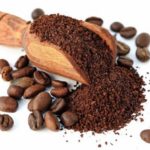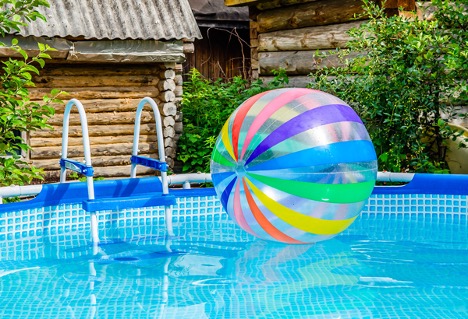Types of coffee makers
Most modern people cannot imagine their morning without a cup of coffee. And the existing rhythm of life, the eternal rush, force us to come up with more and more advanced devices that can save as much time and effort as possible for its preparation. This is how new coffee makers and coffee machines appear.
The content of the article
What types of coffee makers are there?
 The choice of coffee makers is enormous. There are both very simple and cost-effective models, characterized by a simple operating principle and minimal capabilities, as well as more complex models equipped with a wide variety of functions: a timer, temperature control that allows you to keep coffee hot for some time (from half an hour to 3 hours), regulation of strength, etc.
The choice of coffee makers is enormous. There are both very simple and cost-effective models, characterized by a simple operating principle and minimal capabilities, as well as more complex models equipped with a wide variety of functions: a timer, temperature control that allows you to keep coffee hot for some time (from half an hour to 3 hours), regulation of strength, etc.
It is worth paying attention to the volume of coffee that is prepared at one time. As a rule, this information is indicated on the device itself and indicates the number of cups with a capacity of 100 ml. This will help you choose a coffee maker according to the amount of product you or your family consumes.
Types of coffee makers and coffee machines
All coffee makers and coffee machines are designed for one purpose - making coffee. The difference is in the method of extraction from coffee of the components required to obtain the taste and aroma. They also differ in the principle of formation of steam pressure.Depending on these indicators, there are different types of coffee makers and coffee machines.
Geysernaya
 Another name is a steam coffee maker. The model was created back in the 19th century, but until now the components of the design and the principle of operation have not undergone any significant changes. The only innovation is that electric models with a cord that plug into an outlet have appeared. Manual ones are still placed on the stove.
Another name is a steam coffee maker. The model was created back in the 19th century, but until now the components of the design and the principle of operation have not undergone any significant changes. The only innovation is that electric models with a cord that plug into an outlet have appeared. Manual ones are still placed on the stove.
Depending on the volume, coffee makers of this type are produced with different powers - from 450 W to 1 kW. Consist of 3 departments:
- lower water tank made of steel;
- compartments (filters) for ground coffee beans;
- upper container (coffee pot) for ready-made coffee, made of glass, ceramics or steel.
The cooking process takes place in several stages:
- Filtered water is poured into the lower container. The level is determined by the existing mark.
- Ground coffee, preferably medium grind, is placed in the filter. The coffee powder does not need to be compacted, it only needs to be slightly smoothed.
- The filter with coffee is installed above the container with water, and the coffee pot is placed on top. The coffee maker is placed on the stove or plugged into an outlet.
The principle of operation is reflected in the name of the model. When heated to a boil, the water begins to expand and enters a funnel-shaped tube, creating increased pressure. Along it, water, with the help of the generated steam, rises into the filter with ground beans and, passing through it and extracting the necessary components from the coffee, is pushed into the coffee pot. The ejection process resembles a geyser in appearance.
The device is turned off manually. A hissing sound will indicate that the coffee is ready and the water in the container has run out.
Attention! The advantage of a geyser coffee maker is the ability to regulate water heating.The slower it is, the richer the drink turns out.
Rozhkova
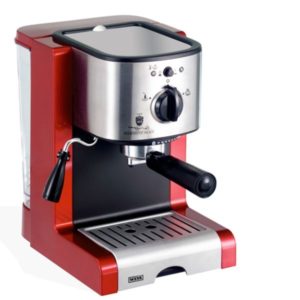 In this model, the compartment for ground coffee is a horn (holder). A special feature of this coffee maker is the need to firmly compact the finely ground coffee powder with a special pestle.
In this model, the compartment for ground coffee is a horn (holder). A special feature of this coffee maker is the need to firmly compact the finely ground coffee powder with a special pestle.
The cooking process takes place under high pressure of steam generated when water boils. It’s not for nothing that the device has another name – espresso (from Italian – under pressure).
Steam is generated in two ways, depending on the type of coffee maker:
- Steam. Steam occurs when water is heated to a boiling point of 100 °C, and under the influence of a pressure of 4 bar, it opens the valve between the water container and the horn. Hot steam passes through the coffee and, extracting coffee substances from it, enters the coffee pot in finished form. It takes about 3-5 minutes to prepare.
- Pump-action. Steam is produced by heating water with an electromagnetic pump to a temperature of 95 degrees. The pressure in this unit is 15 bar, so cooking takes very little time - about 30 seconds, and the consumption of raw materials is reduced. Coffee lovers know that the optimal temperature for brewing is between 92 and 95 °C. Therefore, its quality will be higher than in the steam model.
In carob coffee makers, a “cream” is formed on the coffee – a soft and aromatic foam, appreciated by many gourmets.
Reference! Some carob coffee makers are equipped with a cappuccino maker - an attachment for collecting and frothing milk, which allows you to prepare cappuccino and latte in addition to espresso.
Drip
 Other names: filtration, Americano. They are in great demand due to their low cost and ease of use.
Other names: filtration, Americano. They are in great demand due to their low cost and ease of use.
The device consists of 2 containers: for cold water and a ready-made drink, between which there is a mesh filter with coarse grains. The filter can be paper (disposable), nylon (enough for about 60 cups), metal or “gold” (titanium coated, does not require replacement).
Water, having been heated from the heating element to almost 100 ° C, expands and turns into steam, which passes through the outlet tubes to the upper part of the apparatus. There, the steam condenses and drips in the form of condensate drops through a special hole onto the coffee filter, and then passes through it into the coffee pot. In this case, part of the temperature is lost, reaching approximately 90-97 ° C (ideal temperature for Americano). The disadvantage is the lack of foam.
More expensive models have additional features:
- the coffee pot is located on a heater that can keep coffee hot for 3 hours;
- there is a shutter with an anti-drip function that protects the stove from product residues falling on it when removing the cup from the coffee maker;
- the ability to stop the operation of the device at any stage of preparation.
Interesting! Coffee turns out tastier and stronger in a drip coffee maker, which has the lowest power.
Capsule
 In this model, instead of a filter or a compartment for ground beans, special capsules with compacted coffee powder inside are used. To prevent coffee from oxidizing, losing its taste and spoiling, the capsules are sealed and filled with inert gas. During the cooking process, they are pierced on 3 sides with a special device.
In this model, instead of a filter or a compartment for ground beans, special capsules with compacted coffee powder inside are used. To prevent coffee from oxidizing, losing its taste and spoiling, the capsules are sealed and filled with inert gas. During the cooking process, they are pierced on 3 sides with a special device.
First, an incoming powerful stream of air mixes the contents of the capsule.Heated water then passes through them under pressure. The resulting coffee is poured into a cup. The used capsule is discarded.
On the plus side – there is no need to calculate the required portion of loaded coffee or clean the filter from used coffee mass. Of the minuses – in some devices you can only use capsules from the manufacturer of the coffee maker.
Attention! When choosing a capsule model, pay attention to the volume of noise it produces.
Combined
 Combines 2 types of coffee makers:
Combines 2 types of coffee makers:
- carob, with espresso preparation;
- drip, for fans of Americano.
With such a device, it is worth considering that these drinks require beans of different grinds (fine for espresso, coarse for Americano).
When choosing, you need to pay attention to power. It is desirable that it be at least 1-1.7 kW. Then a pressure of 15 bar will arise.
Semi-automatic
 It is stipulated that part of the work must be done manually before brewing. The device does not grind coffee beans on its own; it must be poured in already ground. Then you need to place the coffee in the filter and compact it properly. This type includes, for example, a horn model.
It is stipulated that part of the work must be done manually before brewing. The device does not grind coffee beans on its own; it must be poured in already ground. Then you need to place the coffee in the filter and compact it properly. This type includes, for example, a horn model.
One of the advantages is that depending on what kind of coffee you prefer (strong, not very strong), you have the opportunity to determine the required amount of raw materials and the resulting volume of the drink.
Automatic
They practically do not require human intervention in the process of making coffee. The device, also called a combine or coffee machine, independently:
- Grinds coffee beans. They are placed in the compartment provided for this purpose, where they are ground according to the specified settings.The ground product enters the pressing department, where it is pressed into a soluble tablet and moistened.
- Heats water to the required temperature. Under pressure, it passes through the compressed powder and fills the cup with the finished product.
- Self-cleaning. The remaining waste is removed into a special container, after which washing occurs.
It takes only 30 to 40 seconds to prepare 1 cup of coffee from the moment you place the beans to pour it into the cup. The big advantage is that due to grinding immediately before preparation, the caffeine and essential oils are completely preserved in the finished coffee. The downside is the high cost.
Advice! It is undesirable to use flavored coffee in automatic machines - it leaves an odor that is difficult to eliminate for a long time.
Manual
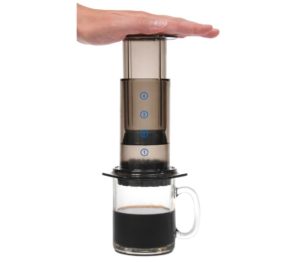 Devices in which coffee is prepared under pressure created by manual muscular force. These include:
Devices in which coffee is prepared under pressure created by manual muscular force. These include:
- French press (French press). It consists of a narrow cylinder, heat-resistant glass and a piston connected to a mesh filter made of metal. Ground coffee beans are poured into the bottom of the cylinder, hot water is poured in, and the lid is closed. The piston is in a raised state. After the coffee has brewed (after 5-7 minutes), the piston moves down, pressing the grounds and passing the finished drink through the filter.
- Aeropress. The principle of operation is the same, with the only difference being that the filter is made of paper and is disposable. It is placed in a mesh lid located at the bottom of the glass cylinder and discarded after the brewing procedure is completed.
- Handpresso (from the English word hand - “hand”). Miniature model that fits in one hand.A piston pump located inside pumps compressed air, creating a pressure of 9 bar. As soon as the pressure gauge needle reaches the green mark, ground coffee is poured into the coffee maker, hot water is poured in, and the filter lid is closed. The finished drink is poured into a cup at the touch of a button.
The advantage of manual coffee makers is their small size, which allows you to take them with you on the road, to the country house, or on any trip. They do not require electricity to function.
What types of coffee makers are there for home?
Coffee makers for home are:
- electric, operating when plugged into the network;
- for making coffee on a stove - gas or induction.
To the above models powered by electricity, you can add an electric Turk. Coffee is prepared in it, just like on a stove, but instead of a stove, it uses a special power stand. The shutdown is not automatic; after the brewing process is completed, the device must be turned off independently.
Stovetop coffee makers
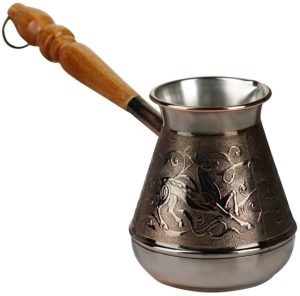 Of the types of coffee makers discussed above, this includes the geyser model (if it is not electric), in which coffee is prepared on a heat source - a gas or induction stove. In addition, there are cezve (cezve), turk, and dalla, known since time immemorial.
Of the types of coffee makers discussed above, this includes the geyser model (if it is not electric), in which coffee is prepared on a heat source - a gas or induction stove. In addition, there are cezve (cezve), turk, and dalla, known since time immemorial.
A cezve is a vessel made of forged copper, steel, aluminum, brass or ceramics, the inner surface of which is coated with food-grade tin to prevent the ingress of substances hazardous to human health that are released when the copper or brass is heated. It has a wide base and a narrow neck, and a long handle, most often made of hard wood.
Most coffee lovers consider Turka to be the same cezve, without making any difference between them.According to one version, the difficult name could not take root in Russia, and since Turkish coffee was the most famous, the vessel began to be called Turk. However, some experts believe that there is still a difference: the Turks have a wider and shorter neck, shaped like a funnel.
Dalla is widely used in the countries of Saudi Arabia and Syria. This is a small, most often copper, vessel with a narrow neck, short spout and thick bottom, having a lid and a straight, long handle. The shape vaguely resembles a teapot.
The existing market for coffee makers and coffee machines offers a huge number of different models and types to suit any, even the most sophisticated, taste. The choice directly depends on the coffee lover’s preferences: desired strength, quantity, favorite recipe, etc. Having made a purchase taking into account all the pros and cons, you can become the owner of a device that can bring true pleasure with a cup of aromatic drink that can charge you with vigor and good mood for the whole day.



